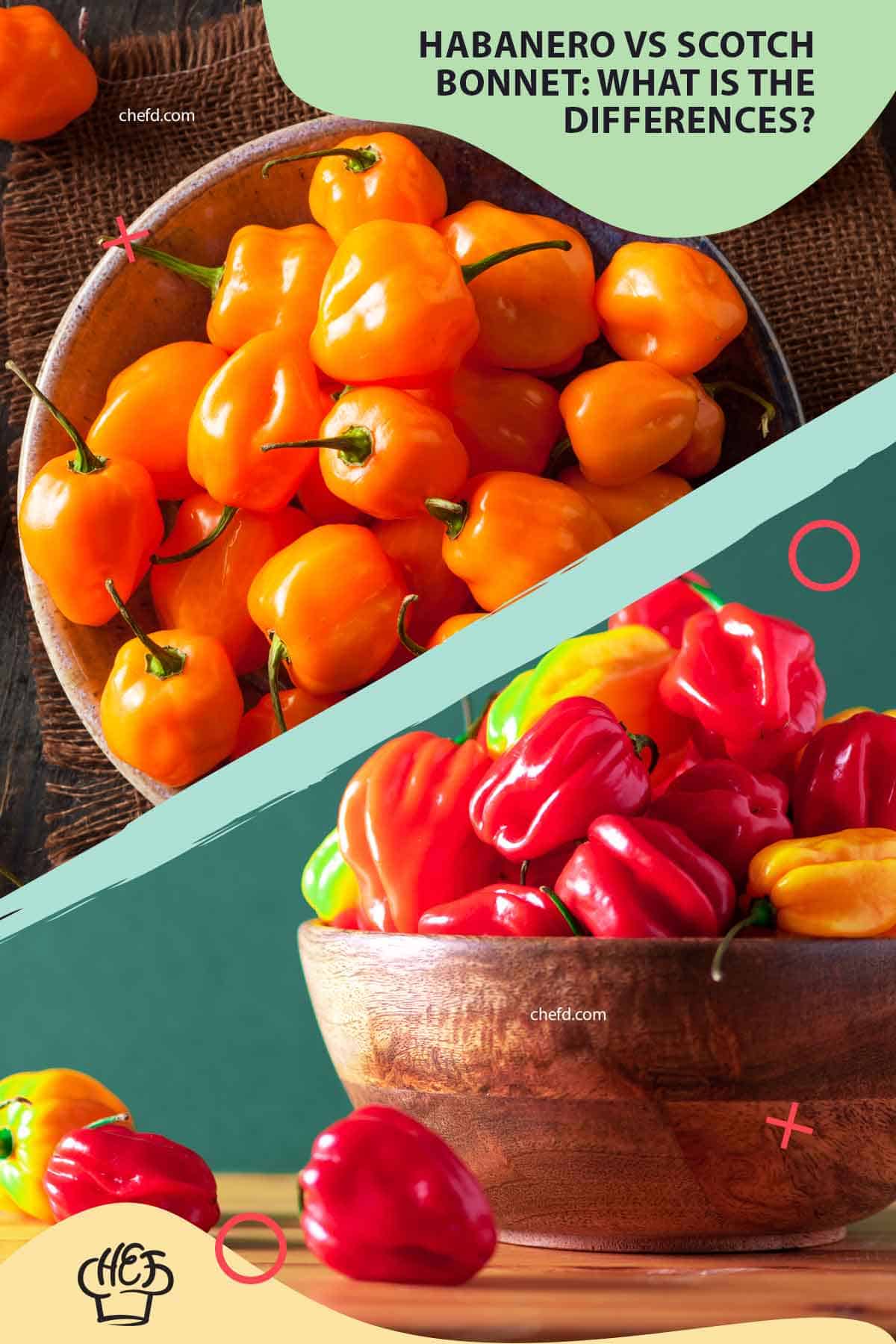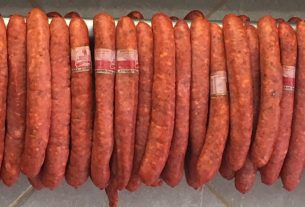Step into the fiery world of chili peppers, where the battle of flavors ignites.
In one corner, we have the Scotch bonnet, a vibrant and potent pepper known for its Caribbean charm.
In the other corner, we have the habanero, with its fierce Latin American flair.
These two powerhouses may share a species, but their unique appearances, distinct flavors, and culinary preferences will soon have you craving more.
Join us as we explore the scorching showdown between scotch bonnet and habanero peppers, and discover which pepper packs the ultimate punch in the kitchen.
scotch bonnet vs habanero
Scotch bonnet and habanero peppers are similar in origin and belong to the Capsicum chinense species.
Although they have similar heat levels, ranging from 100,000-350,000 SHUs, their flavors differ.
Habaneros have a floral and smoky taste with fruity notes, while scotch bonnets have a strong citrus note.
Scotch bonnets are popular in Jamaican cuisine, while habaneros are popular in the Mexican Yucatán peninsula.
Both peppers can be grown in containers or directly in the ground.
Key Points:
- Scotch bonnet and habanero peppers belong to the Capsicum chinense species and have similar heat levels, ranging from 100,000-350,000 SHUs.
- Habaneros have a floral and smoky taste with fruity notes, while scotch bonnets have a strong citrus note.
- Scotch bonnets are popular in Jamaican cuisine, while habaneros are popular in the Mexican Yucatán peninsula.
- Both peppers can be grown in containers or directly in the ground.
scotch bonnet vs habanero – Watch Video


Pro Tips:
1. The Scotch Bonnet pepper, also known as bonney peppers or Caribbean red peppers, shares the same level of spiciness as the Habanero pepper.
2. The Scotch Bonnet gets its name from its unique shape, which resembles a tam o’ shanter hat, traditionally worn by Scottish men.
3. Both the Scotch Bonnet and Habanero peppers belong to the same species, Capsicum chinense, which is native to Central America and the Caribbean.
4. The British Isles have embraced the Scotch Bonnet pepper, incorporating it into traditional dishes like jerk chicken and other Caribbean-influenced recipes.
5. The heat of a Scotch Bonnet or Habanero pepper is primarily derived from the compound called capsaicin, which stimulates nerve endings, causing a burning sensation.
Origin And Classification Of Scotch Bonnet And Habanero Peppers
Scotch bonnet and habanero peppers:
- Scotch bonnet and habanero peppers both belong to the Capsicum chinense species, native to the Americas, particularly the Amazon basin.
- These peppers have spread throughout Central and South America and were later introduced to other parts of the world through exploration and trade.
Unique characteristics and intense heat:
- Both scotch bonnet and habanero peppers have gained popularity and recognition due to their distinct characteristics and intense heat.
-
The scotch bonnet is a staple ingredient in traditional Jamaican cuisine, while habanero peppers hold cultural significance in the Yucatán Peninsula of Mexico, where they are commonly used in various dishes.
-
For bullet points.
- Use markdown bold for important information.
- Add a blockquote to emphasize a point.
Preferred Climate And Soil Conditions For Growing Scotch Bonnet And Habanero Peppers
Scotch bonnet and habanero peppers thrive in warm and humid climates. These peppers are particularly sensitive to frost and require temperatures between 70-90°F (21-32°C) for optimal growth. They also require ample sunlight, making them well-suited for regions with long growing seasons.
Regarding soil conditions, both peppers prefer well-drained soil that retains some moisture. Sandy loam or loamy soil is generally ideal for their cultivation. However, they can tolerate a wide range of soil types as long as they are well-draining. It is important to ensure that the soil is rich in organic matter and has a pH level of 6.0-7.0.
- Scotch bonnet and habanero peppers thrive in warm and humid climates
- They require temperatures between 70-90°F for optimal growth
- Ample sunlight is necessary for their growth
- Well-drained soil that retains some moisture is preferred
- Sandy loam or loamy soil is generally ideal for cultivation
- They can tolerate a wide range of soil types as long as they are well-draining
- Soil pH should be maintained between 6.0-7.0
“Scotch bonnet and habanero peppers thrive in warm and humid climates. They require temperatures between 70-90°F for optimal growth and ample sunlight. Well-drained soil that retains some moisture, such as sandy loam or loamy soil, is preferred for their cultivation. They can tolerate a wide range of soil types as long as they are well-draining. It is important to ensure that the soil is rich in organic matter and has a pH level of 6.0-7.0.”
Visual Differences: Color, Skin Texture, And Blossom End Of Scotch Bonnet And Habanero Peppers
One of the key visual differences between scotch bonnet and habanero peppers lies in their colors. Traditional scotch bonnets are often yellow or red, while traditional habaneros are mainly orange or red. This difference in color adds to their visual appeal and helps distinguish them from one another.
Another distinction can be found in the texture of their skin. Habanero peppers typically have a smoother skin compared to scotch bonnets, which can sometimes present slight wrinkles or bumps. Additionally, the blossom end of habaneros is pointed, while scotch bonnets have a more rounded shape.
Distinctive Flavors: Floral, Smoky, Fruity, And Citrus Notes Of Scotch Bonnet And Habanero Peppers
When it comes to flavor profiles, scotch bonnet and habanero peppers each have unique qualities. Habaneros are known for their distinct floral and smoky flavors, accompanied by fruity undertones. These fruity notes can range from tropical flavors like mango and pineapple to more citrusy tones such as orange and lemon.
Alternatively, scotch bonnets possess a strong citrus note that sets them apart. This citrusy flavor adds a refreshing and tangy element to dishes. When used in cooking, scotch bonnets can infuse a subtle zesty kick that complements a variety of ingredients. The difference in flavors allows cooks and chefs to choose between these peppers based on the desired taste profile they want to achieve in their recipes.
Heat Levels: Comparative Scoville Scale Ratings Of Scotch Bonnet And Habanero Peppers
Both scotch bonnet and habanero peppers are renowned for their fiery heat. On the Scoville scale, which measures the heat intensity of peppers, they typically range from 100,000 to 350,000 Scoville Heat Units (SHU). This places them in the category of extremely hot peppers.
It is worth noting that the heat of habaneros can vary depending on the specific cultivar. Some habanero varieties, known as super-spicy habaneros, have been bred to exceed the usual range and reach higher heat levels. These super-spicy habaneros can climb up to 500,000 SHU or even higher, challenging the taste buds of even the most daring chili enthusiasts.
Similarly, scotch bonnets have been crossbred with even hotter peppers to create extra-spicy varieties. These crossbred scotch bonnets can deliver an exceptional level of heat, giving chili lovers a chance to experience an intensified fiery sensation.
Super-Spicy Varieties: Examples Of Extra-Hot Habaneros And Crossbred Scotch Bonnets
In the world of peppers, there are some exceptional super-spicy habanero varieties that are known for their extreme heat. One such example is the 7 Pot Douglah, which is renowned for its blistering heat that easily surpasses 1,000,000 SHU. Another striking habanero cultivar is the Carolina Reaper, which holds the title of the world’s hottest pepper, reaching an astonishing 1,569,300 SHU.
In the case of scotch bonnets, crossbreeding has led to the creation of even spicier varieties. The Nagabon and the Scorpion Bonnet are prime examples, each combining the scotch bonnet’s citrusy flavor with the intense heat from other potent peppers like the Trinidad Scorpion and Bhut Jolokia. These crossbred scotch bonnets push the boundaries of spiciness, taking the heat enthusiasts on an exhilarating journey.
Cultural Significance: Scotch Bonnets In Jamaican Cuisine And Habaneros In The Mexican Yucatán Peninsula
Scotch bonnet peppers have deep cultural significance in Jamaican cuisine. They are a mainstay ingredient in numerous traditional Jamaican dishes, including jerk chicken, curry goat, and various hot sauces. The scotch bonnet pepper is known for its distinct flavor and fiery heat, which elevate the taste profile of Jamaican cuisine, imbuing it with a unique depth and character that is highly esteemed by both locals and food enthusiasts.
On the other hand, habanero peppers play a vital role in the culinary heritage of Mexico’s Yucatán Peninsula. Yucatecan cuisine is renowned for its vibrant flavors, and habaneros are key to achieving this distinctive taste. These peppers feature prominently in traditional dishes such as cochinita pibil (slow-roasted marinated pork), habanero salsa, and the iconic Yucatecan condiment known as xnipec, a salsa made with onions, vinegar, and plenty of habaneros. Habaneros contribute their characteristic heat and fruity flavors to these dishes, delivering a spicy kick that is highly cherished by both locals and visitors.
Versatile Growing Options: Container Or Ground Cultivation Of Scotch Bonnet And Habanero Peppers
Both scotch bonnet and habanero peppers are versatile options for cultivation, whether in containers or directly in the ground.
When growing in containers, it is crucial to select a pot that is at least 12 inches in diameter and has adequate drainage holes. Fill the container with a well-draining potting mix, ensuring it remains evenly moist without becoming waterlogged. Place the container in a sunny spot or use grow lights to provide the necessary light for the plants.
Alternatively, peppers can also be grown directly in the ground. To do this, choose a location with full sun exposure where the plants can receive 6-8 hours of direct sunlight daily. Prepare the soil by adding compost or well-rotted manure to improve fertility and drainage. Space the plants around 18-24 inches apart to allow for proper airflow and prevent the spread of diseases.
Utilization In Culinary Settings: Popular Applications Of Scotch Bonnet And Habanero Peppers
Scotch bonnet and habanero peppers are widely utilized in various culinary settings, adding heat, flavor, and complexity to a wide range of dishes.
In Jamaican cuisine, scotch bonnets are often used in spicy marinades, jerk seasonings, and fiery hot sauces. They are the key ingredient in dishes like Jamaican jerk chicken, pepper shrimp, and curries, where they bring their distinct citrus note and intense heat to the forefront.
In Mexican cuisine, particularly in the Yucatán Peninsula, habanero peppers are used in numerous recipes, providing a vibrant and spicy kick. The habanero’s fruity flavors and intense heat make it a perfect addition to salsas, sauces, and marinades. It is often paired with tropical fruits like mango or pineapple to create a delightful balance of sweet and spicy flavors. Habaneros are also used in stews, soups, and traditional Yucatecan dishes, contributing to the overall richness and depth of flavor.
- Scotch bonnet and habanero peppers add heat, flavor, and complexity to dishes.
- In Jamaican cuisine, scotch bonnets are used in marinades, jerk seasonings, and hot sauces, bringing a citrus note and intense heat.
- In Mexican cuisine, habanero peppers provide a vibrant and spicy kick to recipes, often paired with tropical fruits for a sweet and spicy balance.
- Habaneros are also used in stews, soups, and traditional Yucatecan dishes, enhancing the overall richness and depth of flavor.
Scotch bonnet and habanero peppers play an important role in various culinary traditions, enhancing the taste and spiciness of numerous dishes.
Conclusion: Exploring The Diversity And Potential Of Scotch Bonnet And Habanero Peppers
Scotch bonnet and habanero peppers, despite their similarities in origin and species, bring their own unique characteristics to the table. From their preferred climates to their distinctive flavors, these peppers offer a world of diversity and options for culinary exploration.
Whether you prefer the strong citrus note of the scotch bonnet or the floral and smoky flavors of the habanero, both peppers excel in delivering fiery heat and enhancing the taste of various dishes. Their versatility in cultivation, coupled with their cultural significance in Jamaican and Yucatecan cuisine, further adds to the allure and popularity of these peppers.
Whether you are using scotch bonnet or habanero peppers in your cooking or seeking to cultivate them in your own garden, the world of flavors and intensity awaits. Embrace the fiery debate and let your taste buds be tantalized by the scotch bonnet and habanero peppers, nature’s gifts of heat and flavor.

You may need to know these questions about scotch bonnet vs habanero
Which is hotter habanero or scotch bonnet?
Based on the provided background information, the Scotch bonnet pepper is hotter than the habanero pepper. While both peppers have a similar hotness rating ranging between 100,000-350,000 SHU, the Scotch bonnet pepper holds a higher rating of about 445,000 SHU, whereas the habanero pepper has a rating of approximately 260,000 SHU. Therefore, if you’re looking for a spicier option, the Scotch bonnet pepper would be the hotter choice.
Are Scotch bonnets and habaneros the same thing?
Although Scotch bonnets and habaneros belong to the same pepper family and share similar spiciness and fruity flavors, they do have distinct characteristics. The Scotch bonnet pepper boasts a sweeter taste, enhancing its appeal in certain culinary dishes. Conversely, the habanero pepper tends to exhibit a more citrusy profile, occasionally bordering on a mild bitterness. This divergence in flavor is what sets these two peppers apart, making them slightly different but equally tantalizing choices for spice enthusiasts and chefs alike.
Can I use habanero instead of scotch bonnet?
Yes, habanero peppers can be used as a great alternative to scotch bonnets in your recipes. These peppers share a similar flavor profile and heat level, making them a suitable substitute. Additionally, habaneros are more readily available, which makes them a convenient choice for those who have difficulty sourcing scotch bonnets. Simply substitute habanero peppers for scotch bonnets in a 1:1 ratio to achieve a similar taste and spice level in your dishes.
What tastes better habanero or scotch bonnet?
While both habanero and scotch bonnet peppers share a delightful fruity and tropical flavor, the slight difference in sweetness sets them apart. Scotch bonnet peppers tend to be sweeter, making them especially suited for Caribbean dishes where sweetness plays a crucial role in achieving the desired taste. However, in a pinch, a habanero pepper can still provide a satisfying substitute with its similar taste profile, albeit with slightly less sweetness. Ultimately, the choice between habanero and scotch bonnet peppers depends on the specific flavor required to enhance a dish.
Reference source
https://peppergeek.com/scotch-bonnet-vs-habanero/
https://dingolayhotsauce.com/scotch-bonnet-vs-habanero-pepper/
https://foreignfork.com/scotch-bonnet-vs-habanero-the-similarities-and-differences/
https://peppergeek.com/scotch-bonnet-pepper-substitutes/



